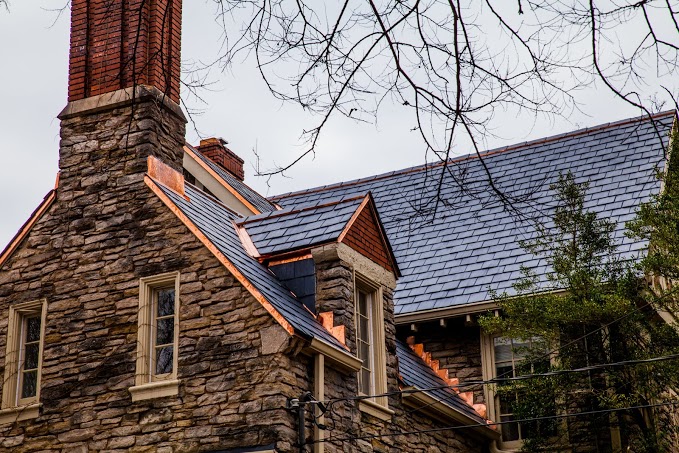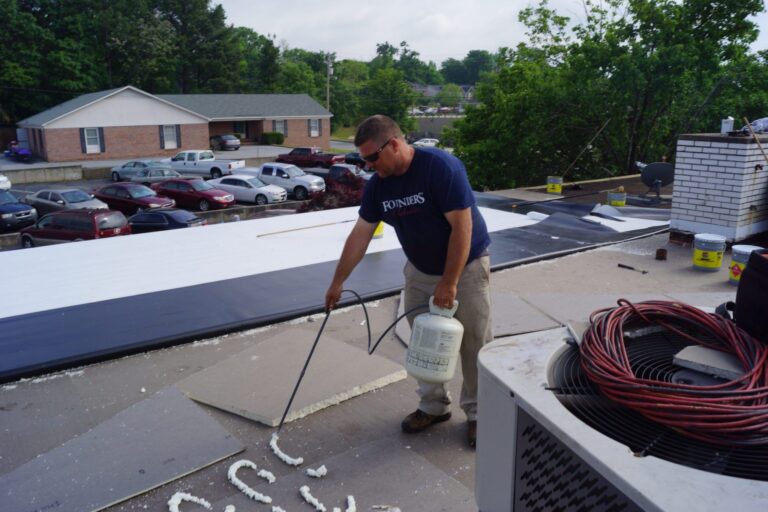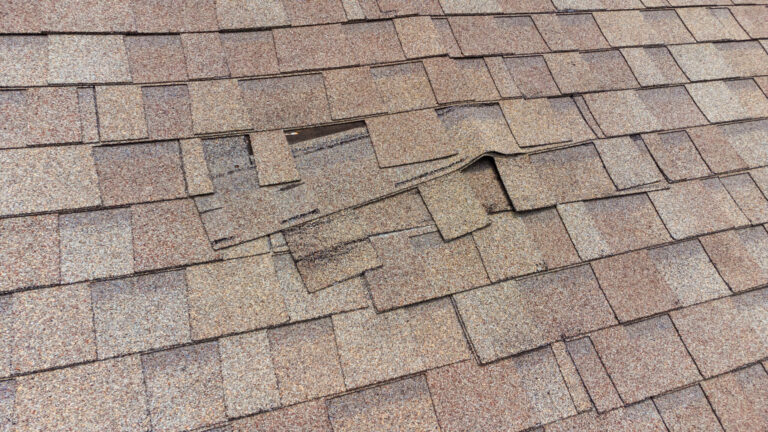
What Is the Best Material for Flat Roofs?
Nashville’s leading commercial roofing experts, MidSouth Construction, bring a wealth of experience in flat roof technology to the forefront. The evolution of flat roofing materials has seen a significant transformation over the past century, moving from bitumen-based solutions to modern plastic polymer products. With seven distinct types of roofing materials available in the Nashville area, selecting the right one is crucial for both new constructions and roof renovations. As Nashville Commercial Roofers, let’s dive into a discussion on our top 7 choices for flat roofing materials!
Seven Types of Roofing Materials for Flat Roofs:
What is Built-Up Roofing?
Commonly found on older structures, this flat roof design features a multi-layer waterproofing system comprised of tar and paper, topped with gravel. The inclusion of gravel enhances impact and fire resistance, while the underlying multiple layers serve as a redundancy strategy. Even if one layer is removed, there is another layer below, seamlessly continuing the protective function. Although the materials in Built-Up Roofing (BUR) have evolved over time, transitioning from tar and paper to more robust fiberglass sheeting, the fundamental principle of this roofing system remains unchanged.
Built-up Flat Roof:
- Found on older buildings, this multi-layer tar and paper system with a gravel topping provides impact and fire resistance.
- Multiple layers below act as a redundancy strategy
- Tar and gravel can also add weight to a roof structure
- Finding leaks can be a challenge on this type of roofing
- Regular maintenance is essential to address issues like gravel displacement and leaks
What is Modified Bitumen Roofing?
This system offers two variations: a hot adhesive type, necessitating a blow-torch for application to the roof, and a cold adhesive version that conveniently rolls out and can be tamped down during installation.
While a single-ply product lacks the built-in redundancy characteristic of a built-up flat roof, it compensates with a robust, impact, and fire-resistant coating. Moreover, it ensures a safe walking surface during the installation process and is notably lighter, eliminating the need for additional structural support.
Although a modified bitumen roof may entail a slightly higher upfront cost compared to a built-up roof, potential savings arise from the absence of installation expenses when undertaking the project independently. Both systems boast an expected lifespan of at least 15 to 20 years, ensuring enduring durability.
Modified Bitumen Roof:
- A modern alternative to built-up roofs, it offers tough-wearing impact and fire-resistant properties.
- Available in hot and cold adhesive options.
- Lighter product requiring no additional structural support
- Expected lifespan of 15 to 20 years with proper maintenance.
What is Single Ply EPDM Roofing?
Described by some as akin to covering a roof with a bicycle inner tube, it is lauded for its ease of repair. Single Ply EPDM typically comes in a black hue. In contrast to bitumen-based systems, an EPDM roof boasts an extended lifespan up to 50 years. Its remarkable resistance to UV rays and temperature extremes makes it an ideal choice for roofs subjected to sub-zero conditions regularly. When installing EPDM over a structure with an existing bitumen-based system, thorough cleaning of all traces of bitumen, grease, adhesives, and associated debris is imperative.
In cases of uncertainty, it is advisable to over-board or re-board the roof deck before affixing EPDM, as it relies on a solid and clean adhesive bond between the material’s underside and the substrate. Additionally, the availability of various widths facilitates seamless installation without the need for adding seams.
Single Ply EPDM:
- Known as rubber roofing, it is suitable for both commercial and domestic projects.
- With a lifespan of up to 50 years, it surpasses bitumen-based systems and excels in UV and temperature resistance.
- Generally comes in black which is not always energy efficient
- Thorough cleaning is essential when installing over a pre-existing bitumen-based system.
- White in color, it offers durability and flexibility, serving as an alternative to EPDM and PVC.
- Recognized for its superior performance as an effective flat roofing system.
- Energy efficient and can reduce utility costs
What is Single Ply TPO Roofing?
Thermoplastic polyolefin, or TPO for short, is a type of single-ply roofing material that is heat-reflective and energy-efficient. In laymen terms, TPO roofing belongs to the broader category of rubber roofing materials. Generally, TPO comes in white and contains a blend of rubbers and fillers that add to its durability and flexibility. TPO roofs are seen in both commercial and residential roofing and it’s popularity is growing fast, especially in the Nashville commercial roofing market. TPO roofing was introduced in the 1990s as an economical alternative to PVC roofing. Over the last several decades, TPO has become popular due to its superior performance as an effective flat roofing system for commercial properties. Primarily, TPO is touted as a more energy-efficient alternative to EPDM. As demand for more energy-efficient roofing increases, so does the popularity of TPO. For more information read our other blog post about TPO Roofing!
Single Ply TPO Roofing:
- A heat-reflective and energy-efficient material
- Extremely popular for flat roofs in the Nashville commercial roofing market.
- White in color, it offers durability and flexibility, serving as an alternative to EPDM and PVC.
- Recognized for its superior performance as an effective flat roofing system.
- Energy efficient reducing utility costs
What is Commercial Metal Roofing?
Metal roofing stands out as an environmentally conscious choice, given its recyclable nature, making it a green roofing material. Particularly well-suited for low-slope roofs, synonymous with flat roofs, galvanized steel sheet roofing is celebrated for its straightforward installation, aesthetic appeal, and robust durability. Adaptable to pitches as low as 3/12, it proves versatile enough to cover various existing roof structures.
For those prioritizing aesthetics, the standing seam system emerges as the top choice, characterized by a sleek appearance with no visible fixings and interlocking panels at the joints. Conversely, the screw-down system is recommended for structures like back-of-house or garage settings.
Metal roofing’s popularity is further fueled by its commendable resistance to fire and impact damage, underscoring its reliability as a roofing material. Additionally, its recyclability adds an environmentally friendly dimension, aligning with green construction practices.
Commercial Metal Roofing
- Ideal for low-slope roofs, galvanized steel sheet roofing provides easy installation and durability.
- Standing seam systems with no visible fixings offer aesthetic appeal, while the screw-down system is recommended for utility structures.
- Resistant to fire and hail impact damage
- Known for simplicity and customization
- Can easily be retrofitted over any existing roof
What is a Green Roof?
Hybrid green roofing necessitates careful consideration from your structural engineer due to its increased weight compared to other roofing systems. It is not recommended as the primary defense against the elements but rather serves as a protective layer atop an existing roof finish.
This approach significantly extends the lifespan of previously mentioned roof finishes by several decades. The initial step involves covering the entire flat roof area with an impermeable membrane, such as a butyl pond liner, serving dual purposes of water retention and acting as a root barrier to prevent plant intrusion into the roof space.
Drought-resistant plants like succulents and mosses, chosen for this option, efficiently absorb and retain moisture. The growing medium is intentionally shallow at approximately 2″, complemented by a 3″ drainage layer beneath to discourage the growth of unwanted self-seeding plants.
Ensuring safe access for periodic weeding is advisable, making this method an excellent way to enhance views from upper stories, seamlessly integrating your roof with the surroundings, or fostering essential biodiversity in urban settings.
Hybrid Green Roof:
- Considered a protective layer, it adds weight to the structure and extends the lifespan of other roofing systems.
- Features an impermeable membrane, preventing water retention and acting as a root barrier.
- Incorporates drought-resistant plants, enhancing biodiversity and blending with the environment.
What is a Roof Coating?
Roof coatings serve the purpose of safeguarding and prolonging the functional lifespan of roof assemblies, a necessity for both new constructions and, more frequently, existing roof coverings such as BUR, metal, modified bitumen, single-ply membranes, and spray polyurethane foam. Distinguishing themselves from paint, roof coatings are notably thicker with a higher solids content. Formulated to shield roofs from adverse weather conditions and environmental factors like UV light, excessive water, and wind, these coatings are designed to provide long-lasting protection.
Their elasticity is a standout feature, often containing a significant quantity of top-quality resin, ensuring the coating maintains its flexibility throughout its life cycle. Upon curing, these resins create a resilient elastomeric film, adding an extra layer of waterproofing and enabling the coating to span small cracks and membrane seams found on roofs. In contrast to the application of paint in measured portions per 100 square feet, roof coatings are administered in multiple gallons per 100 square feet. The market offers a variety of roof coatings suitable for diverse roof types, with the most common types including acrylic coatings, asphalt coatings, polyurethane coatings, and silicone coatings. MidSouth Construction is an authorized applicaton with various roof coating manufacturers, including American Weatherstar which offers a durable roof coating product that comes with a long term warranty! We used this durable product on a commercial church building in Nashville which resulted in a beautiful new roof that with a 20 year warranty!
Roof Coatings:
- Designed to protect and extend the life of roof assemblies
- Offer weather and UV resistance.
- Thicker than paint, they bridge small cracks and seams, providing an additional waterproofing layer.
- Common types include acrylic, asphalt, polyurethane, and silicone coatings.
- Come with long term warranties
- Most affordable option for an existing commercial roof
So, What is the best material for flat roofs?
Choosing the Best Flat Roofing Material:
Selecting the best flat roofing material for your commercial roofing project involves considering various factors. A budget-friendly choice is a roof coating system, providing a practical solution for those seeking affordability and quick installation. For a mid-range alternative with added assurance, the single ply TPO system stands out, offering a 30-year workmanship warranty for flat roof replacements. Additionally, the aesthetic appeal of a metal roof makes it an excellent choice for finishing low-slope roofs on commercial properties.
Determining the best flat roof finish for your project requires assessing your roofing budget, long-term building goals, and the current roof materials. As the top-rated Nashville Commercial Roofers, MidSouth Construction is dedicated to assisting you in finding the ideal flat roofing product. Take advantage of our free commercial roof inspections and estimates to make an informed decision tailored to your specific roofing needs.
Table of Contents
Relevant Articles

10 Questions To Ask A Commercial Roofer Before You Hire Them
10 Questions to Ask a Commercial Roof Contractor before You Hire them If you are a property management company, a commercial property owner, or perhaps on the board of directors for a condo property, roofing repairs and replacements can be a tough topic to bring up, but it doesn’t have to be. At MidSouth Construction we understand that your primary

Top 10 Roof Repairs Every Homeowner Should Know About
Fast. Affordable. Quality Roof Repairs Top 10 Essential Roof Repairs Every Homeowner Should Know About The roof is your home’s first line of defense against the elements, and it’s crucial to keep it in top shape. Whether you’re a new homeowner or have lived in your house for years, understanding essential roofing repairs can save you time and money in

ROOFING 101: ESSENTIAL REPAIRS AND MAINTENANCE
ROOFING 101: ESSENTIAL REPAIRS AND MAINTENANCE Searching for “roofing companies near me” in Nashville? How do you know who to trust? This blog post takes the guesswork out of finding a quality roofer. We’ll share insider tips on what to look for, questions to ask, and how to ensure you get the best value for your investment. Understanding Common Roof
